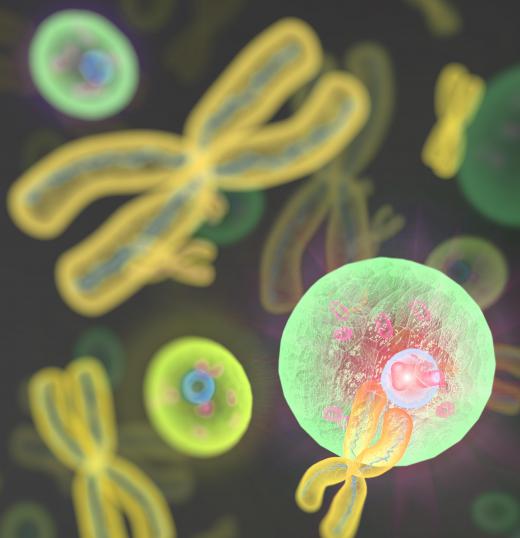What is Chromatin?
Chromatin, also called heterochromatin, is DNA in the nucleus of a cell that has been condensed and sometimes modified into a relatively inactive state. The majority of most human DNA exists in this condensed state at any given time, which allows its over six-foot length to fit within the microscopic confine of the nucleus. DNA condensation is not a random event, and special mechanisms in the cell carefully regulate condensation and relaxation of the nucleic acids, depending on which genes are necessary for cell function at any given time. These mechanisms handle actions including DNA unwinding, gene site identification, and DNA repair, and each involves its own proteins and enzymes.
Formation of chromatin commonly occurs by a process called methylation, in which groups of atoms called methyl groups are added to DNA. This is not the only DNA modification that can spur chromatin formation, but it is one of the most common. Methylation signals that a particular region of DNA shouldn't be read or used for anything at the moment, so it should coil into its condensed form until needed again. DNA condensation doesn't happen because of methylation alone because other proteins and molecules are involved, but methylation is often the first step.

The process of chromatin formation can at times be so extensive that an entire chromosome is essentially inactivated. This happens frequently in animals in which two X chromosomes designate the development of a female. One X chromosome in each cell is randomly deactivated by being condensed into chromatin without detriment to the organism. This X chromosome inactivation is the reason for the random patches of fur color on tortoiseshell cats; the coat color gene is on the X chromosome, and the color that is expressed depends on the chromosome that is active. The condensed chromosome, often called a Barr body, may be completely inactive, but often retains some small measure of activity.

Accessing DNA that has been condensed into chromatin is often a two-fold process, involving reorganization of the condensed DNA and removal of any modifications that previously signaled condensation. The release of condensed DNA is called chromatin remodeling and can happen very quickly, usually in thousandths or millionths of a second. The resultant structure of the released DNA is very important to how genes are read and translated. Shuffling between condensed and accessible DNA is essential for a cell to function properly, and these transitions happen millions of times every second in the human body.
AS FEATURED ON:
AS FEATURED ON:












Discussion Comments
@miriam98 - There is a tortoiseshell cat that roams about our neighborhood. I never would have suspected that the reason for its color splotches is that its DNA is going through reorganization.
I had always thought that all color variations within a species were by design. I do agree with you, however, it is an amazing process.
It never ceases to amaze me how brilliant the processes involved in DNA activity are. In this chromatin definition we see something happening that is similar to writing important information on a scroll, then rolling it up and tucking it away.
When we need to access the information, we unroll the scroll, a process called “remodeling”! To top it off, the scroll is six feet long!
I sometimes wonder if we can learn from the design processes in nature and apply it to our own information systems. Perhaps we can build a model of information technology which scrolls up information in this manner, allowing us to put more and more information in smaller and smaller spaces.
Post your comments